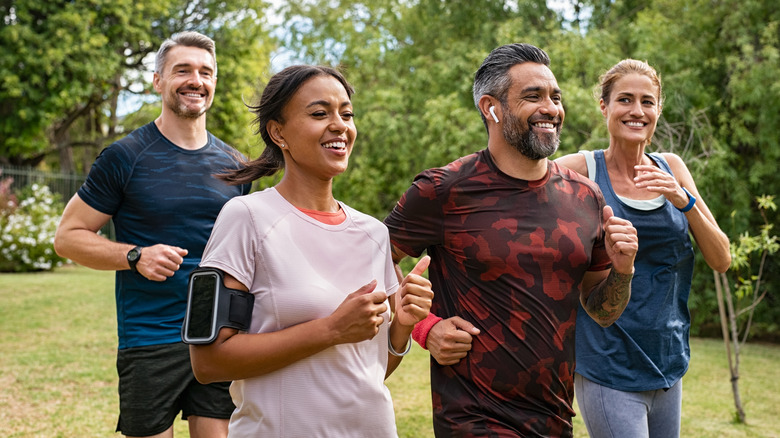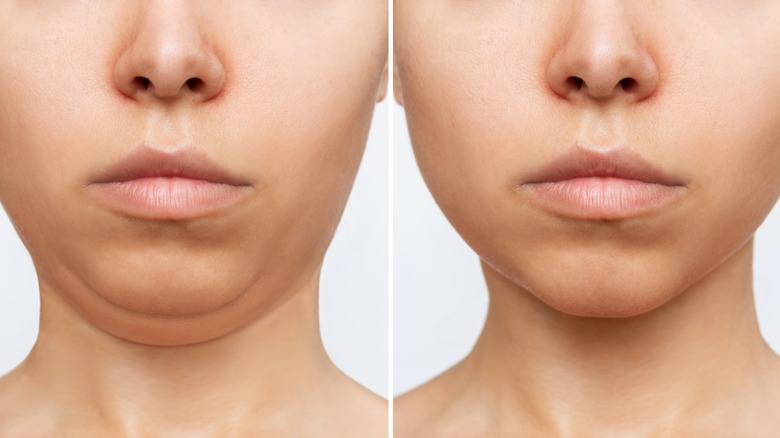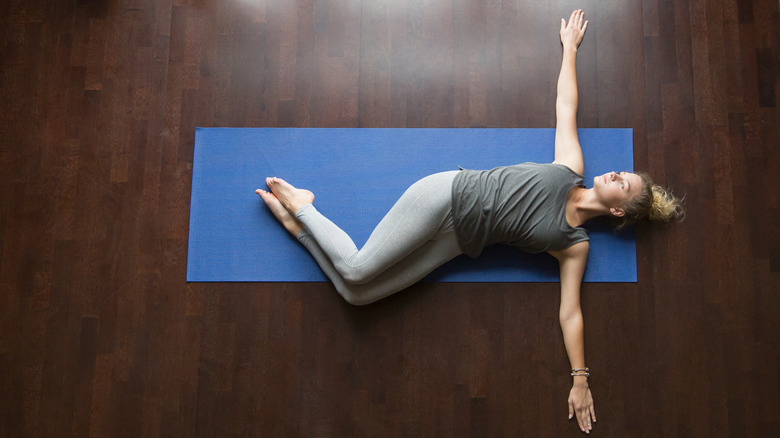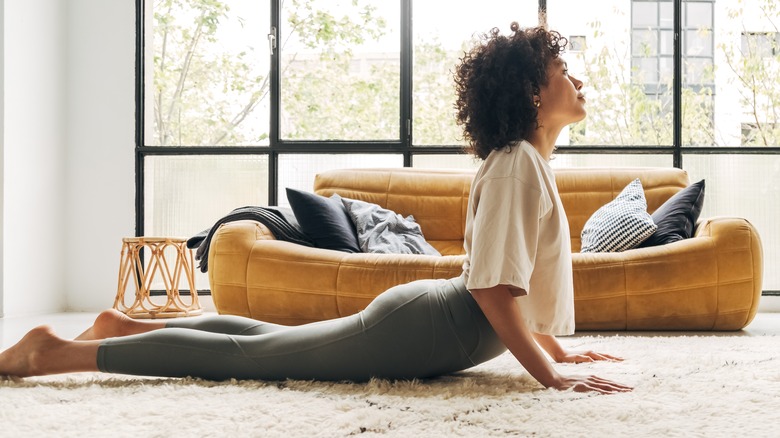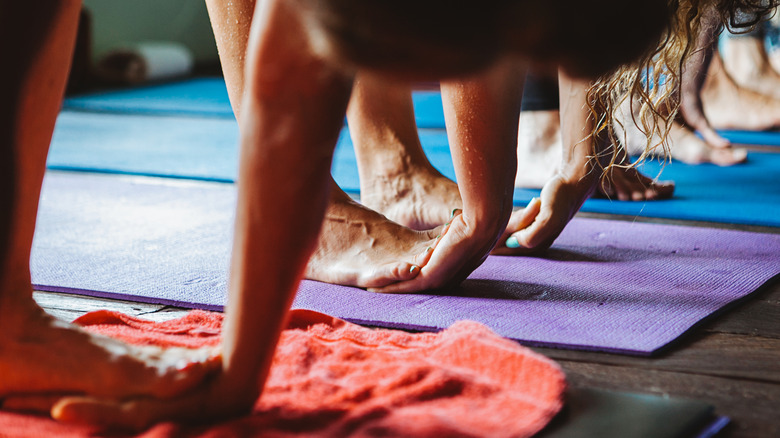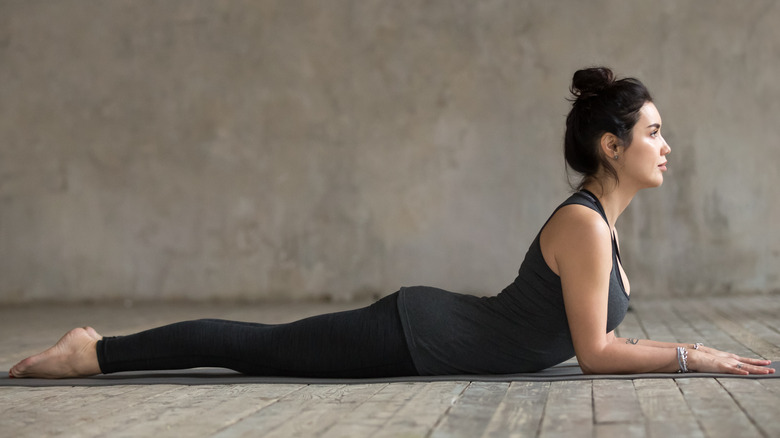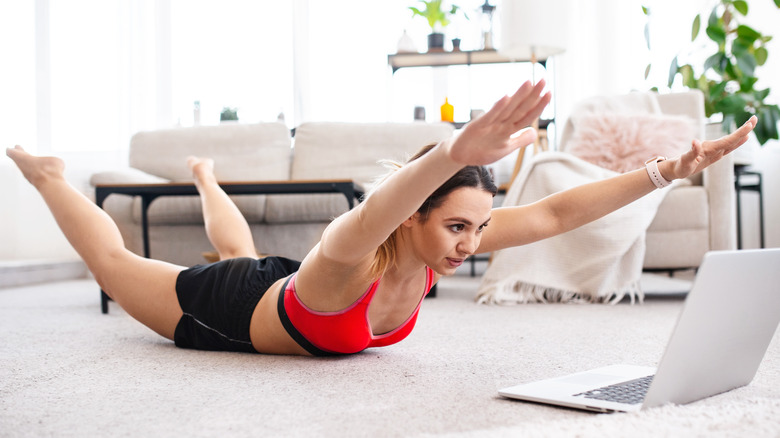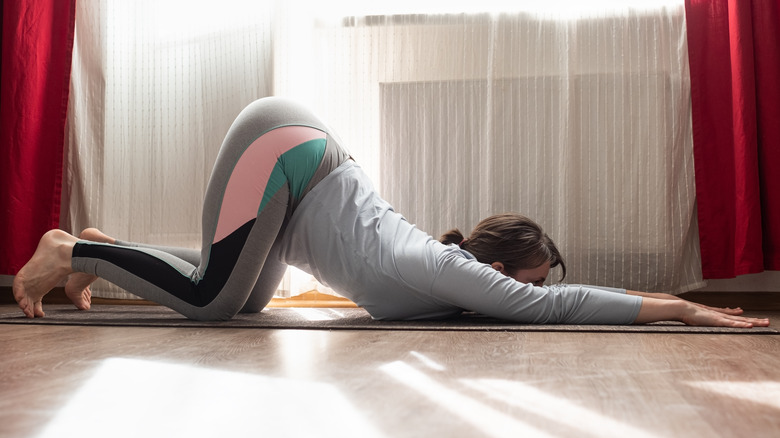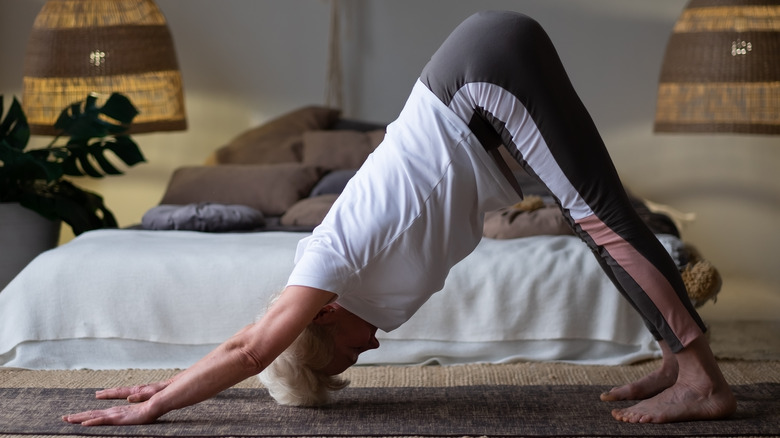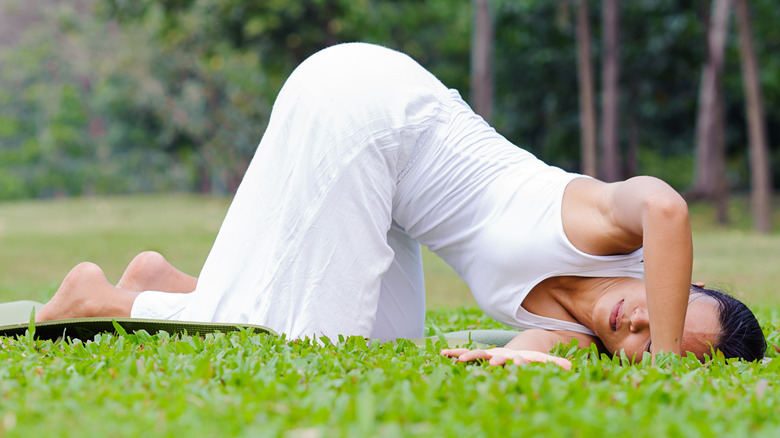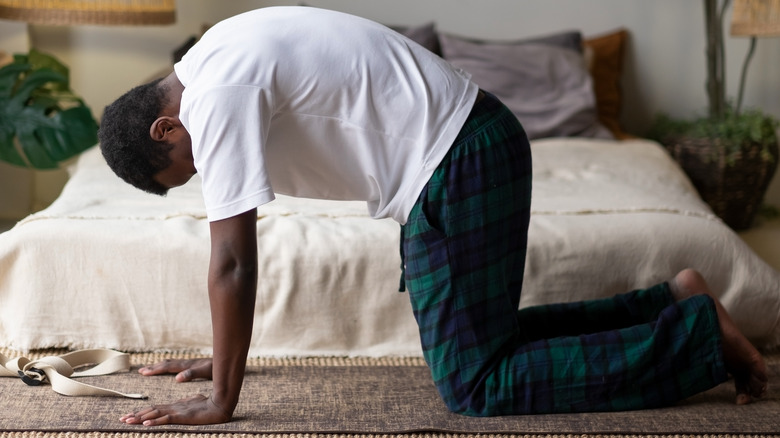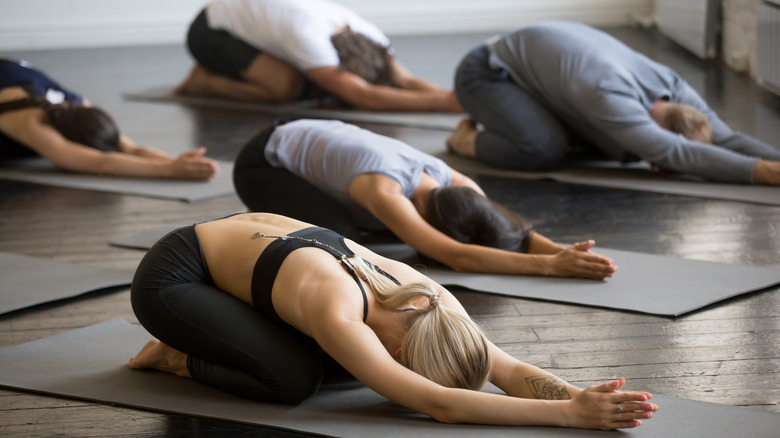Exercises To Help Ease 'Tech Neck' Pain
You've seen it before. People sitting on public transportation, waiting in line to get coffee, out at dinner, at the supermarket — holding their phone and staring down at the screen. You might be doing it right now as you read this.
"Tech neck," also sometimes called "text neck," refers to the act of looking down at an electronic device — like a phone, tablet, or computer screen — and the pain that results from that prolonged stress (via Health Matters). On average, Americans spend seven hours each day on electronic devices, which includes about three hours and 43 minutes on their phone, and over half of that time scrolling through social media (via Comparitech). And for those that work on a computer all day, the numbers are higher.
"Tech neck" occurs because as you look down, the muscles in your neck have to hold up your head — the longer you are gazing down, the harder those muscles have to work. Eventually, these muscles get tired and sore from being overworked. "Tech neck" can result in muscle soreness, stiffness, neck and shoulder pain, headaches, pain in the upper back, tingling or numbness in your hands, temporomandibular joint (TMJ) problems, and even affect your posture (via Everyday Health).
Tips to avoid 'tech neck'
If you sit at a desk, you may be doing it wrong. Many people wrongly assume they should sit up straight when using a computer, or they have been told by a medical professional to sit that way. However, sitting up straight puts a lot of pressure on your lower back as well as your neck muscles. In fact, spine surgeon Dr. K. Daniel Riew recommends sitting in a chair that can recline about 25-30 degrees so that you can slightly lean back. You should also use something for lumbar support to prevent yourself from hunching over. Sitting this way gives your neck muscles a much needed break.
Another important tip is to move around often. If you have a job that requires you to sit all day, get up frequently to walk or change position. Dr. Riew recommends taking a break every 15-30 minutes to stand up and walk around, even if it's just for one minute, to get your blood moving and give your neck muscles some variation. Or see if you can get a standing desk so you can alternate between sitting and standing while you work. Sitting for long periods is not only bad for your neck, but can also reduce your life span (via Health Matters).
The importance of cardio
If you suffer from "tech neck," Dr. K. Daniel Kiew advises to seek help from a doctor or physical therapist first, instead of going directly to a surgeon. Over time, if left unaddressed, "tech neck" can lead to arthritis, or bulging or ruptured discs, which can pinch a nerve and sometimes require surgery (via Everyday Health). There are many exercises you can practice to help relieve "tech neck" pain. Always check in with your doctor or physical therapist before starting an exercise program, especially if you've had a recent injury, or have been diagnosed with scoliosis, a herniated disc or spinal fracture (via Livestrong).
First of all, it's important to get aerobic activity every week, like biking, running, swimming, or using an elliptical. Just make sure you choose an activity that doesn't aggravate your neck pain. Cardio can help with "tech neck" because this type of exercise increases your oxygen intake, heart rate and blood circulation — all of which can help to reduce muscle pain and inflammation (via Health Matters). Plus, after 30 minutes of sustained cardio, your body releases endorphins, which are hormones that stimulate your body's opiate receptors that help reduce pain (via Spine Health).
Chin tucks
Chin tucks are an easy and simple movement you can practice to help relieve neck pain. To practice, start sitting or standing with straight posture. Slowly pull your head backward, until you create a double-chin. You should feel a stretch at the base of your skull and top of your neck. Try not to lean your head back as you practice this motion and keep your chin parallel to the ground. Hold this position for a count of five, then gently release.
Try to practice this exercise 10 times, two to three times per day. You can even practice this movement intermittently during work while sitting at your desk. This exercise helps counterbalance the motion of "tech neck," which usually involves subconsciously pushing your head forward while looking at a computer screen or phone (via Everyday Health). This movement can help improve your posture, strengthen your neck muscles, and increase mobility and flexibility (via Spine Health).
Exaggerated nod
Another stretch you can try is an exaggerated nod. This exercise offsets the movement of "tech neck" by requiring you to pull your shoulders down and back, and is basically the exact opposite of gazing down at your screen — it involves gazing up toward the sky. The movement can help increase your neck mobility and decrease neck pain. To practice, you can begin sitting or standing. Focus on relaxing your posture and releasing tension in your shoulders before starting. Begin with your mouth gently closed, so that your teeth are touching but your jaw is not clenched.
Slowly start to look up, keeping your mouth closed. When you can't look up any further, stay here and softly release your jaw — opening your mouth and allowing gravity to pull your jaw downward. After this, keep your mouth open and try to tilt your head back a little bit further — but don't force it. Then, pause here and slowly close your mouth. You should feel a stretch in the front of your neck, near your throat (via Healthline).
T-spine windmill stretch
This movement can help stretch your shoulder muscles, relieving built-up tension and pressure in your neck and shoulders, and increasing mobility (via Physio on a Roll). To practice this exercise, start lying down on your right side with your legs stacked and your knees touching. Bend your knees and hips, each at a 90-degree angle. Stack your arms as well, left arm on top of the right, with your palms touching and your arms straight. Then slowly start to lift your left arm up to the sky then over to the left, resting it on the ground to make a T shape with your upper body. Try to keep pressing both of your shoulder blades into the ground.
Slowly lift the left arm again to re-stack it back on top of your arm, retuning to where you started. Repeat this movement for about 30 seconds, then roll over to your left side and do the exercise on that side (via SELF).
Cobra pose
Many yoga poses can help relieve neck pain because they involve both stretching and strengthening many of the surrounding muscles. Cobra pose helps stretch the back of the neck and can offset the imbalance "tech neck" often creates in the body (via Everyday Health). To practice cobra pose, begin lying down on your stomach with your legs hip-width apart and the tops of your feet resting on the ground. You may want to lie on a soft surface, or yoga mat if you have one. Bend the elbows and place your palms on the floor next to your ribs. As you inhale, engage your glutes and begin to slowly lift your head and upper chest off the ground, looking straight down at the ground and only slightly supporting yourself with your hands. Healthline advises to stay here if you have low back issues or neck pain — this is called low cobra.
If you would like to move into full cobra, press into your palms and straighten your arms, without locking the elbows. Lift your stomach off the ground and look forward, focusing on lengthening your spine and the back of your neck. Stay in the pose for 15-30 seconds, then release.
Hand-under-foot pose
Hand-under-foot pose is a variation of the traditional yoga pose called standing forward fold. Padahastasana in Sankrit, this exercise helps to stretch the neck and hamstrings, and can be helpful for those with a desk job that requires sitting all day. To practice this movement, it's best to take off your shoes and start standing with your feet hip-width apart. Slowly bend forward, hinging at the hips and reaching your arms toward the floor. Don't force it — just move as deep as feels comfortable. Then, start to bend your knees and put your weight into your heels, lifting the balls of your feet off the ground high enough that you can slide your hands underneath your toes.
Move your hands under your feet, palms face up, all the way until your toes are touching your wrist. Press the balls of your feet into your palm and try to relax your head, releasing all of the muscles in your neck. Hold this position for three deep breaths, then release (via Healthline).
Sphinx pose
Sphinx pose is helpful for stretching the muscles in your low back, chest, and shoulders. It is a good preparatory pose to practice before going into cobra pose, according to Yoga Journal. To practice sphinx pose, start by lying on your stomach with your legs straight, side-by-side, and the tops of your feet resting on the ground. Put your elbows on the ground underneath your shoulders, and rest your forearms and palms face down on the ground. Make sure your forearms are parallel to each other. Press into your elbows to lift your chest up.
Squeeze your thighs and glutes to press your hips into the ground and focus on lengthening your spine and relaxing your shoulders. You should feel a stretch in your low back muscles, with no pain — if you feel any discomfort, come out of the pose. Try to hold this shape for at least 30 seconds, then release (via SELF).
Superman
The superman is another great exercise that can help you conquer "tech neck" pain by strengthening the muscles in your back, supporting the spine and healthy posture (via Everyday Health). To practice this movement, you will start lying down on your stomach on the ground or a yoga mat, with your legs and arms straight and your arms extending forward in front of you. As you do the movement, make sure your head stays in a neutral position and try not to look up (via Healthline). Slowly lift your right arm and your left leg off the ground, and pause for a couple seconds, then lower back down.
When you lift up, make sure to activate your glutes, abs, and the muscles between your shoulder blades. Then, slowly lift your left arm and right leg up, hovering for a couple seconds, then lowering to the ground. This is one rep. Try to do 8-12 reps, for a total of 2-3 sets, resting in between each set.
Eventually, if you'd like to practice the full superman, you will lift both arms and both legs a couple inches off the ground at the same time, balancing on your core. Again, make sure to not lift your head and continue gazing downward to protect your neck.
Extended puppy pose
The extended puppy pose helps to stretch the muscles in your back, chest, and shoulders and is a combination of child's pose and downward-facing dog. It also can stretch your glutes — tight hips and glutes can sometimes be linked to neck pain (via SELF). To practice this pose, start on your hands and knees with your hands underneath shoulders and knees under hips. Tuck your toes and begin to slowly move your hands forward, extending your arms straight and pressing palms into the ground as you focus on pulling your hips back toward your heels.
Try to keep your arms engaged, continually reaching them away from you and keeping your elbows off the ground. Rest your forehead on the ground and try to relax the muscles in your neck. Stay in this shape for 30 seconds to one minute, breathing deeply (via Yoga Journal).
Downward-facing dog
Downward-facing dog is one of the most classic yoga postures. This pose can help open the chest and shoulders, which offsets the imbalance that "tech neck" creates, as we often round the spine and hunch the shoulders when looking at screens. This pose can be a challenge for beginners, especially if you don't have a lot of upper-body strength, so make sure to not allow your shoulders to creep up toward your ears — focus on pulling your shoulders down your back to help lengthen your neck (via Healthline).
To practice downward dog, start on a flat non-slip surface or yoga mat on your hands and knees, with your hands slightly in front of your shoulders and your knees under your hips. As you exhale, begin to lift your knees off the ground and your hips up toward the sky. If you prefer, keep a slight bend in your knees and have your heels hover above the floor (via Yoga Journal). Release your head and lengthen through the neck. Press your heels toward the ground and push your chest toward your legs, as you lengthen through your spine.
Be sure your wrist creases stay parallel to the short side of your mat and you're pressing the knuckles of your thumb and pointer into the ground to protect your wrists. If you can, stay in this shape for at least three deep breaths, or longer if you'd like, then release.
Thread-the-needle pose
Thread-the-needle is a gentle pose that helps stretch your shoulders and chest, which can reduce neck pain and tension as well as increase mobility (via Livestrong). To practice this exercise, start on your hands and knees, with your wrists underneath your shoulders and your knees under hips. Extend your right arm underneath and across your body, moving it in between your left arm and left thigh. Rest your right arm on the ground with your palm facing up. Slowly start to bend your left arm, and rest your right shoulder and the right side of your head on the ground. Slightly lean toward the right until you feel a stretch in the back of your right shoulder. Hold for one deep round of breath, in and out, then gently return to hands and knees. Continue this movement for at least 30 seconds, then switch sides and repeat (via SELF).
Cat/cow
Cat/cow is another dynamic and traditional yoga pose that can help improve posture and decrease neck pain. It involves moving through two different yoga poses: cat and cow. Moving through these postures can help you gain awareness of your spine, as well as your neck, shoulders, and hip muscles. To practice this flow, start on your hands and knees, with your hands placed underneath your shoulders, your knees under your hips, and the tops of your feet resting on the ground. Gaze down at the ground a couple inches in front of your fingers and focus on lengthening your spine.
To move into cat pose: exhale, tuck your chin into your chest, tuck your tailbone, and pull your spine toward the sky, arching your back like a cat. Then, move into cow pose by inhaling, pulling your belly toward the ground and looking up. Focus on pulling your shoulder blades away from each other and down your back — your abs and hips should fuel this movement. Move through this flow several times, or as long as feels comfortable (via Healthline).
Child's pose
Child's pose is an iconic yoga pose that not only promotes stress relief and releases muscle tension, but it stretches the entire trapezius, the muscles in the back of your neck and shoulders. To practice this posture, start on your hands and knees. If you're on a yoga mat, move your knees toward the outer edges of your mat — if not, just slide your knees so they are a little wider than your hips. Bring your feet together behind you so that your big toes are touching. Move your hips toward your heels, then fold forward, extending your arms out straight to rest along the ground.
Rest your stomach on your thighs and your forehead on the ground. You should feel the muscles in your shoulders and back activate, as well as your hips and glutes. Gently push your chest toward the floor as you reach your fingers forward. Stay in this shape for at least 30 seconds, breathing deeply (via SELF). Imagine all of your stress melting out of your body and your muscle tension dripping away.



